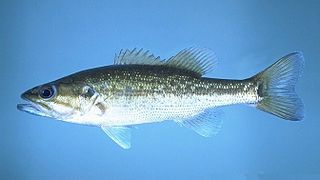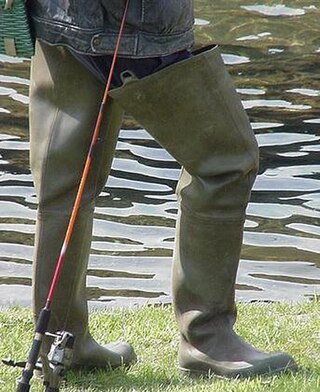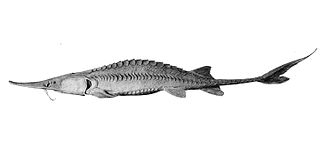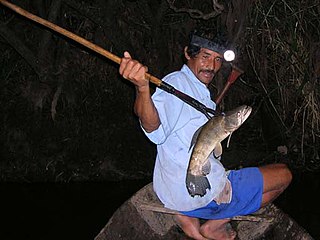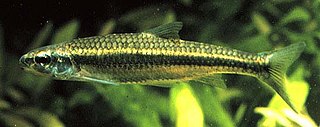Found in the table below are fish found in Missouri separated by the Family that they are in. The list is not complete as there are over 200 species of fish found in Missouri. [1] [2]
| Common name | Scientific name | Picture | Habitat | Notes |
|---|---|---|---|---|
| Acipenseridae (family) | ||||
| Lake sturgeon | Acipenser fulvescens |  | Bottom of lakes and big rivers over sand, gravel, or rock bottom | Endangered |
| Amiidae (family) | ||||
| Bowfin | Amia calva |  | Sloughs, sluggish rivers to medium rivers with moderate flow | |
| Anguillidae (family) | ||||
| American eel | Anguilla rostrate |  | Large rivers w/ moderate flow | |
| Atherinidae (family) | ||||
| Brook silverside | Labidesthes sicculus |  | Clear, warm waters without current, backwaters, overflow pools of large streams | |
| Catostomidae (family) | ||||
| River carpsucker | Carpiodes carpio |  | Lakes, reservoirs, large sluggish rivers | |
| Quillback | Carpiodes cyprinus |  | Large to medium sized rivers with swift flow, lakes | |
| Highfin carpsucker | Carpiodes velifer | Lakes, reservoirs, large sluggish rivers | ||
| White sucker | Catostomus commersonii |  | Rocky pools of small cool streams or big rivers, lakes | |
| Blue sucker | Cycleptus elongates |  | Deep channels of large rivers with swift flow | ENDANGERED |
| Northern hogsucker | Hypentelium nigricans |  | Rocky riffles, flowing pools of cool small to medium streams | |
| Bigmouth buffalo | Ictiobus cyprinellus | 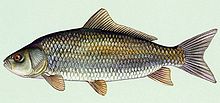 | Streams, rivers, bayous, backwaters, lakes | |
| Black buffalo | Ictiobus niger |  | Deep waters of medium to large-sized rivers, lakes | |
| Smallmouth buffalo | Ictiobus bubalus |  | Medium to large-sized rivers, lakes | |
| Spotted sucker | Minytrema melanops |  | Large rivers, streams with deep pools, sloughs, backwaters | |
| Silver redhorse | Moxostoma anisurum |  | Muddy to rocky bottom pools, small streams to big rivers | |
| River redhorse | Moxostoma carinatum | Small streams, rivers with moderate current over gravel bottom | ||
| Black redhorse | Moxostoma duquesnei |  | Lakes, river pools with sand or rock bottom | |
| Golden redhorse | Moxostoma erythrurum |  | Clear pools of large rivers, moderate flowing small streams with sandy or gravel bottom | |
| Shorthead redhorse | Moxostoma macrolepidotum |  | Rocky pools and riffles, small streams, large rivers | |
| Centrarchidae (family) | ||||
| Shadow bass | Ambloplites ariommus |  | Cool clear streams with moderate flow, logs, roots of live trees | |
| Ozark bass | Ambloplites constellatus |  | Cool clear streams with moderate flow, logs, roots of live trees | |
| Rock bass | Ambloplites rupestris | 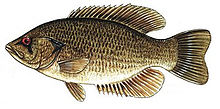 | Cool clear streams with moderate flow, logs, roots of live trees | |
| Flier | Centrarchus macropterus |  | Sluggish streams, ditches, wetlands with heavy vegetation | |
| Green sunfish | Lepomis cyanellus |  | Clear to muddy water, small streams and big rivers, lakes, reservoirs | |
| Warmouth | Lepomis gulosus |  | Sluggish streams, ponds, lakes, wetlands with vegetation, flooded trees | |
| Orangespotted sunfish | Lepomis humilis |  | Sluggish, slow flowing rivers and streams with muddy bottom | |
| Bluegill | Lepomis macrochirus |  | Pools in warm, clear streams with moderate flow, ditches, ponds, lakes | |
| Dollar sunfish | Lepomis marginatus |  | Sluggish streams, backwaters, bayous | |
| Longear sunfish | Lepomis megalotis |  | Slow pools in moderate flowing small to large streams with rocky bottoms, lakes | |
| Redear sunfish | Lepomis microlophus |  | Pools in slow moving warm streams, ponds, lakes with vegetation | |
| Redspotted sunfish | Lepomis miniatus |  | Small to moderate flowing streams with slow current, oxbows, swamps | |
| Smallmouth bass | Micropterus dolomieu |  | Cool, clear, rocky streams with moderate flow, deep reservoirs | |
| Spotted bass | Micropterus punctulatus |  | Warm creeks and rivers with pools, deep reservoirs | |
| Largemouth bass | Micropterus salmoides |  | Slow moving streams, farm ponds, lakes, reservoirs | |
| White crappie | Pomoxis annularis |  | Lakes, reservoirs, large ponds, moderate streams | |
| Black crappie | Pomoxis nigromaculatus |  | Lakes, reservoirs, large ponds, clear streams | |
| Clupeidae (family) | ||||
| Gizzard shad | Dorosoma cepedianum |  | Quiet water habitats, lowland lakes, pounds, pools, backwaters of streams and rivers | |
| Cottidae (family) | ||||
| Banded sculpin | Cottus carolinae |  | Quiet water habitats, lowland lakes, pounds, pools, backwaters of streams and rivers | |
| Grotto sculpin | Cottus specus | Found in 5 caves and one stream in Perry County | ENDANGERED | |
| Cyprinidae (family) | ||||
| Central stoneroller | Campostoma pullum | Small to medium sized streams with moderate to high gradients and rocky or bedrock substrates in or near riffles | ||
| Common carp | Cyprinus carpio |  | Lakes, reservoirs, ponds, ditches, rivers, creeks | INVASIVE |
| Grass carp | Clenopharyngodon idella | 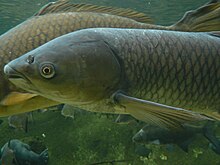 | Large rivers, streams, ponds, lakes | INVASIVE |
| Cypress minnow | Hybognathus hayi | Backwaters of large, sluggish rivers, oxbow | ENDANGERED | |
| Silver carp | Hypophthalmichthys molitrix | 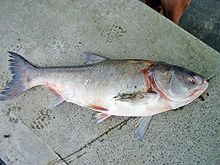 | Large rivers and lakes | INVASIVE |
| Bighead carp | Hypophthalmichthys nobilis |  | Large rivers and lakes | INVASIVE |
| Common shiner | Luxilus cornutus | Small, moderately clear streams, gravel and rubble bottoms, bedrock pools | ||
| Duskystripe shiner | Luxilus pilsbryi | Stream pools with clean gravel bottoms | ||
| Bleeding shiner | Luxilus zonatus | Midwaters, small creeks, large rivers, clean, gravelly or rocky bottoms, near riffles or in pools | ||
| Black carp | Mylopharyngodon piceus |  | Lakes, rivers, streams – escaped from a fish farm during a high water event | INVASIVE |
| Hornyhead chub | Nocomis biguttatus |  | Clear streams with permanent flow and clean gravel | |
| Golden shiner | Notemigonus crysoleucas |  | Sloughs, ponds, lakes, quiet pools of streams | |
| Fathead minnow | Pimephales promelas |  | Mid water or near bottom, streams, pools | |
| Flathead chub | Platygobio gracilis | Big rivers, bottom composed of sand and fine gravel | ENDANGERED | |
| Creek chub | Semotilus atromaculatus |  | Pools in headwater streams, large rivers with rocky bottom | |
| Esocidae (family) | ||||
| Grass pickerel | Esox americanus vermiculatus |  | Small headwater streams | |
| Northern pike | Esox lucius |  | Lakes, reservoirs, rivers, streams with vegetation | |
| Muskellunge | Esox masquinongy |  | Clear waters of weedy lakes and medium rivers | |
| Chain pickerel | Esox niger |  | Lakes, reservoirs, rivers, streams with vegetation | |
| Fundulidae (family) | ||||
| Blackspotted topminnow | Fundulus olivaceus |  | Large lowland rivers, pools of streams | |
| Blackstripe topminnow | Fundulus notatus | Large lowland rivers, pools of streams | ||
| Hiodontidae (family) | ||||
| Goldeye | Hiodon alosoides | Large rivers, backwaters, lake | ||
| Ictaluridae (family) | ||||
| Black bullhead | Ameiurus melas |  | Slow flowing streams, oxbows, backwaters with mud bottom | |
| Brown bullhead | Ameiurus nebulosus |  | Oxbows, backwaters with mud bottom, slow flowing streams | |
| Yellow bullhead | Ameiurus natalis |  | Slow flowing streams, backwaters, vegetated ponds, lakes | |
| White bullhead | Ameiurus catus |  | Clear streams, dam tail waters | |
| Blue catfish | Ictalurus furcatus | 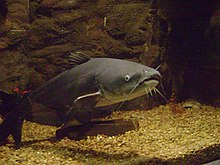 | Rivers and large creeks with fast water over sandy or rocky bottoms | |
| Channel catfish | Ictalurus punctatus | 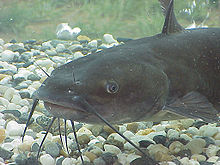 | Ponds, lakes, moderate-flowing rivers and creeks with sandy or gravel bottoms | |
| Mountain madtom | Noturus eleutherus | Large, moderately clear rivers | ENDANGERED | |
| Stonecat | Noturus flavus |  | Clear, gravel-bottom streams | |
| Neosho madtom | Noturus placidus |  | Medium to large stream, clear waters | ENDANGERED |
| Flathead catfish | Pylodictis olivaris |  | Large rivers and creeks with flow near logs, roots, rocks, and debris | |
| Lepisosteidae (family) | ||||
| Alligator gar | Atractosteus spatula |  | Large slow flowing rivers, lakes, bayous, reservoirs | |
| Shortnose gar | Lepisosteus platostomus |  | Muddy rivers, oxbows, backwaters, lakes | |
| Longnose gar | Lepisosteus osseus |  | Bayous, backwaters, oxbows, large creeks, rivers, lakes | |
| Moronidae (family) | ||||
| Hybrid striped bass | Morone chrysops x Morone saxatilis |  | Large streams with moderate flow, sandy or rocky bottom, reservoirs | |
| White bass | Morone chrysops |  | Large streams with moderate flow, sandy or rocky bottom, reservoirs | |
| Striped bass | Morone saxatilis |  | Large deep reservoirs | |
| Percidae (family) | ||||
| Crystal darter | Crystallaria asprella |  | Open channels of large, clear streams | ENDANGERED |
| Greenside darter | Etheostoma blennioides |  | Swift to moderate current streams and rivers | |
| Arkansas darter | Etheostoma cragini | Shallow, spring branches and spring-fed creeks with sandy bottoms – found in Spring River system of the southwestern Ozarks | ||
| Harlequin darter | Etheostoma histrio |  | Streams and ditches, prefers sandy bottoms where logs, sticks, and other organic debris are present | ENDANGERED |
| Johnny darter | Etheostoma nigrum |  | Pools, slow moving riffles in sandy streams | |
| Goldstripe darter | Etheostoma parvipinne | Small, shallow, spring fed streams, with low to moderate gradient | ENDANGERED | |
| Logperch | Percina caprodes | 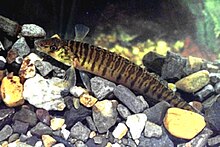 | Deep riffles and silt free pools, small to medium sized rivers | |
| Sauger | Sander canadensis |  | Turbid water in streams and rivers with moderate or fast flow, large lakes, reservoirs | |
| Walleye | Sander vitreus |  | Deep water of large streams, lakes, reservoirs with sandy or rocky bottom | |
| Petromyzontidae (family) | ||||
| Chestnut lamprey | Ichthyomyzon castaneus | Large streams and small rivers, large reservoirs | ||
| Polyodontidae (family) | ||||
| Paddlefish | Polyodon spathula | 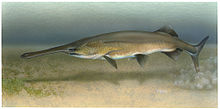 | Channels in large rivers to medium rivers with moderate flow | |
| Sciaenidae (family) | ||||
| Freshwater drum | Aplodinotus grunniens |  | Medium to large rivers, lakes, reservoirs with deep water | |
| Salmonidae (family) | ||||
| Rainbow trout | Oncorhynchus mykiss |  | Large rivers to small streams, lakes, below dams | |
| Brown trout | Salmo trutta |  | Lakes, small streams, large rivers | |
| Umbridae (family) | ||||
| Central mudminnow | Umbra limi |  | Bogs, sloughs, swamps, sluggish streams | ENDANGERED |
